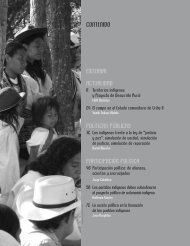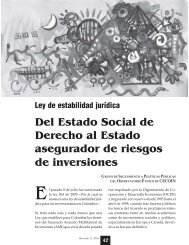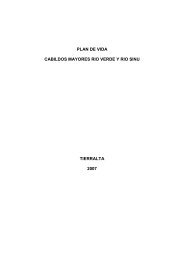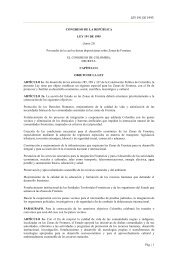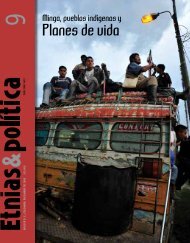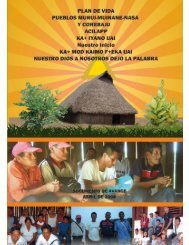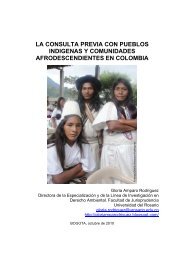resguardo indigena de la asunción 2005 - Observatorio Étnico Cecoin
resguardo indigena de la asunción 2005 - Observatorio Étnico Cecoin
resguardo indigena de la asunción 2005 - Observatorio Étnico Cecoin
You also want an ePaper? Increase the reach of your titles
YUMPU automatically turns print PDFs into web optimized ePapers that Google loves.
P<strong>la</strong>n <strong>de</strong> Vida – Resguardo Indígena <strong>de</strong> La Asunción <strong>2005</strong> - 2020<br />
aprovechamiento, <strong>la</strong> oferta natural se ha ido afectando y hoy por hoy se tiene<br />
otra realidad que es necesario enfrentar y tomar <strong>de</strong>cisiones al respecto.<br />
Para el caso <strong>de</strong>l Resguardo <strong>la</strong> Asunción, se hace una recuperación<br />
<strong>de</strong>scriptiva sobre <strong>la</strong> oferta natural existente en cada época y área, que<br />
traduce a un calendario ecológico <strong>de</strong> oferta ambiental, como sigue:<br />
CALENDARIO ECOLOGICO DEL RESGUARDO LA ASUNCIÓN<br />
MES NOV DIC ENE FEB MAR ABR MAY JUN JUL AGO SET OCT<br />
EPOCAS<br />
AREA<br />
Montaña<br />
RASTROJO<br />
REBALSE<br />
POTREROS Y<br />
AREAS DE<br />
VIVIENDAS<br />
VERANO<br />
Las P<strong>la</strong>ntas<br />
Se caen <strong>la</strong>s hojas y florecen<br />
algunos árboles como el Palo<br />
<strong>de</strong> Arco.<br />
Florece el guamo, el mango,<br />
<strong>la</strong> guayaba<br />
Dan fruto el Patava, el seje,<br />
wuasaí, <strong>la</strong> uva caimarona, el<br />
chontaduro, el moriche, <strong>la</strong><br />
palma <strong>de</strong> cumare el maraco,<br />
el naranjo, <strong>la</strong> toronja, <strong>la</strong><br />
mandarina.<br />
Los Animales<br />
Las gallinetas ponen huevos,<br />
los loros, <strong>la</strong>s tortugas<br />
(charapa y matamata), <strong>la</strong><br />
guacharacas, el pajuil, el<br />
cachirre.<br />
Tienen cría <strong>la</strong> <strong>la</strong>pa, el mico,<br />
churuco y el titi<br />
Hay hormiga manivara<br />
Abundan los zancudos<br />
su alimento. Bueno para <strong>la</strong><br />
caza.<br />
Abunda el chaqueto y el<br />
venado.<br />
Tienen crías <strong>la</strong>s <strong>la</strong>pas,<br />
VERANO<br />
SAN JOSE<br />
Pagina No. 66<br />
INVIERNO<br />
Se pesca Yamú Se pesca<br />
Rebalsa<br />
Las P<strong>la</strong>ntas<br />
El pasto se seca<br />
Se rotan los potreros y se<br />
quema el pasto para que<br />
retoñe y salga bueno.<br />
Carga el guamo.<br />
Se caen <strong>la</strong>s hojas <strong>de</strong> champa<br />
y florece<br />
Hay cosecha <strong>de</strong> naranja,<br />
mandarina, toronja coco,<br />
guayaba y limón.<br />
El Ganado<br />
Debe dársele sal al ganado .<br />
Se rota <strong>de</strong> potrero en busca<br />
<strong>de</strong> buen pasto.<br />
Las P<strong>la</strong>ntas<br />
Las p<strong>la</strong>ntas dan frutos y se<br />
fortalecen el mango,<br />
naranjas y mandarinas<br />
Se cogen hormigas culonas<br />
Los Animales<br />
Los animales dan cría<br />
como <strong>la</strong> tortuga, los loros y<br />
aves.<br />
Abunda el zancudo.<br />
Las P<strong>la</strong>ntas<br />
Retoñan <strong>la</strong>s p<strong>la</strong>ntas y<br />
vuelven a crecer los<br />
árboles que botan pepas.<br />
Los Animales<br />
Buscan sus cuevas para<br />
vivir, rastrojos viejos<br />
Época <strong>de</strong> zancudo<br />
- El pasto se recupera<br />
Florecen los frutales cerca<br />
<strong>de</strong> <strong>la</strong> casa<br />
VERANO<br />
COMETAS<br />
INVIERNO<br />
Comienza a<br />
dar frutos<br />
los árboles<br />
sembrados<br />
cerca a <strong>la</strong>s<br />
viviendas.




